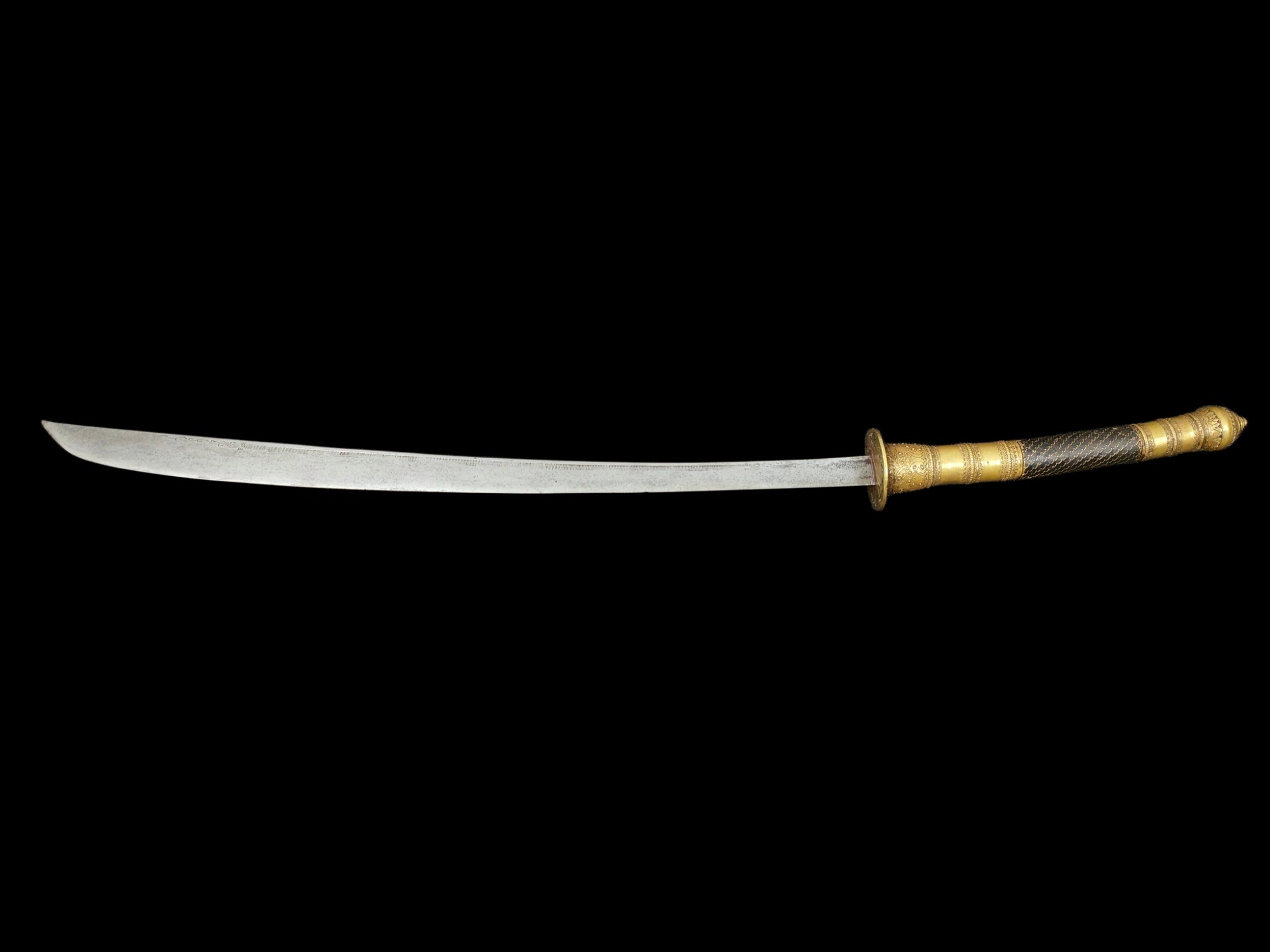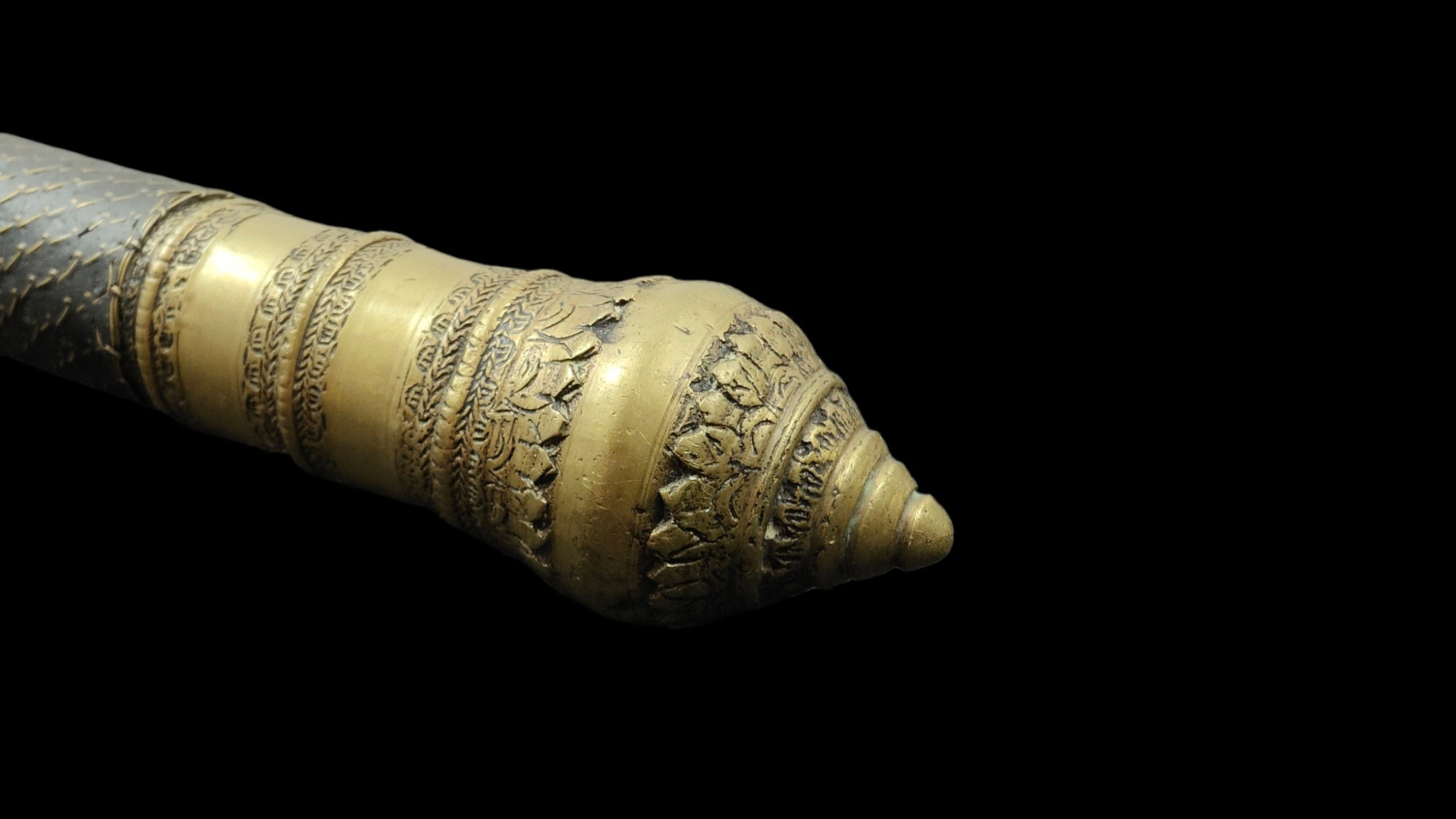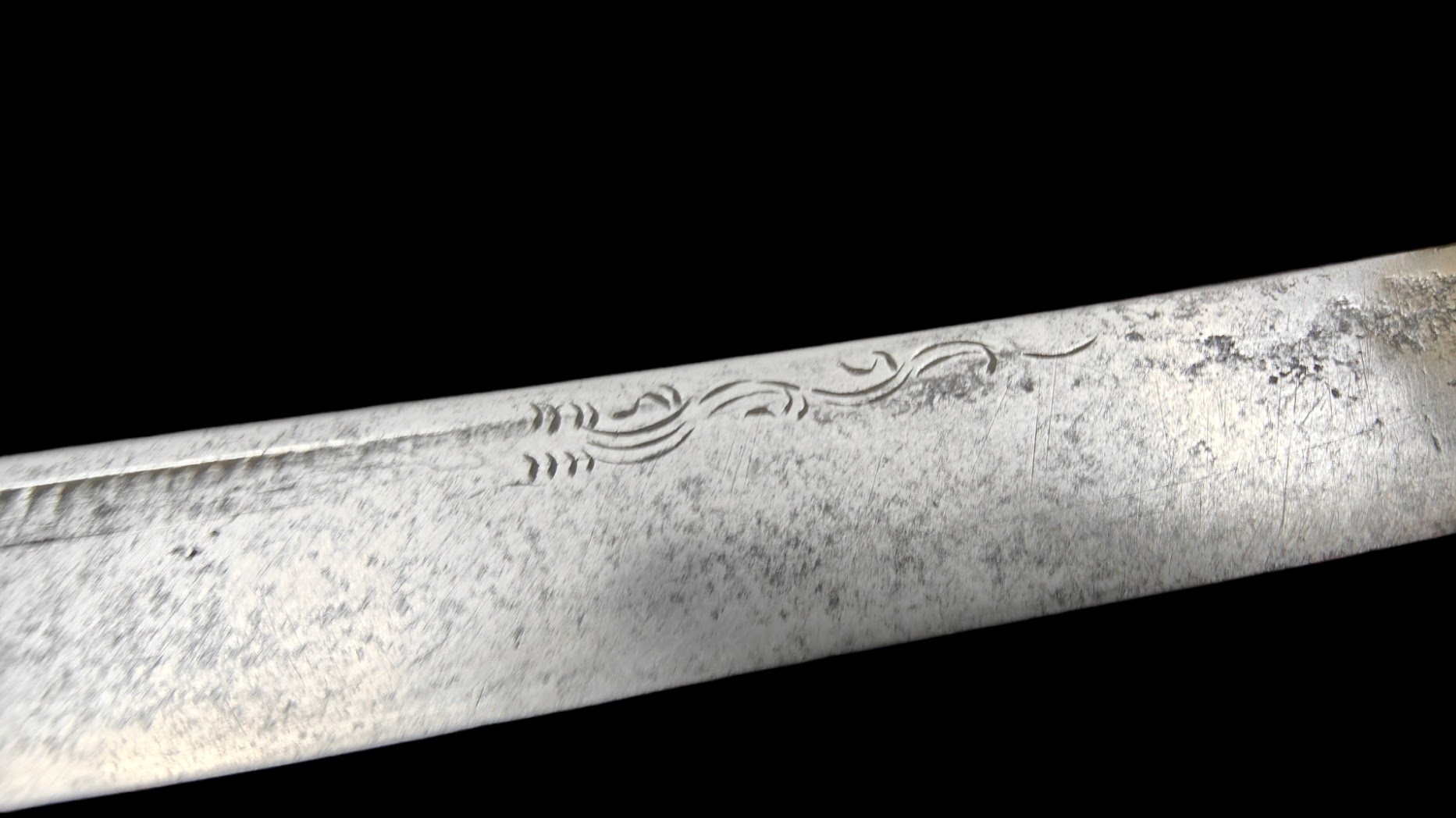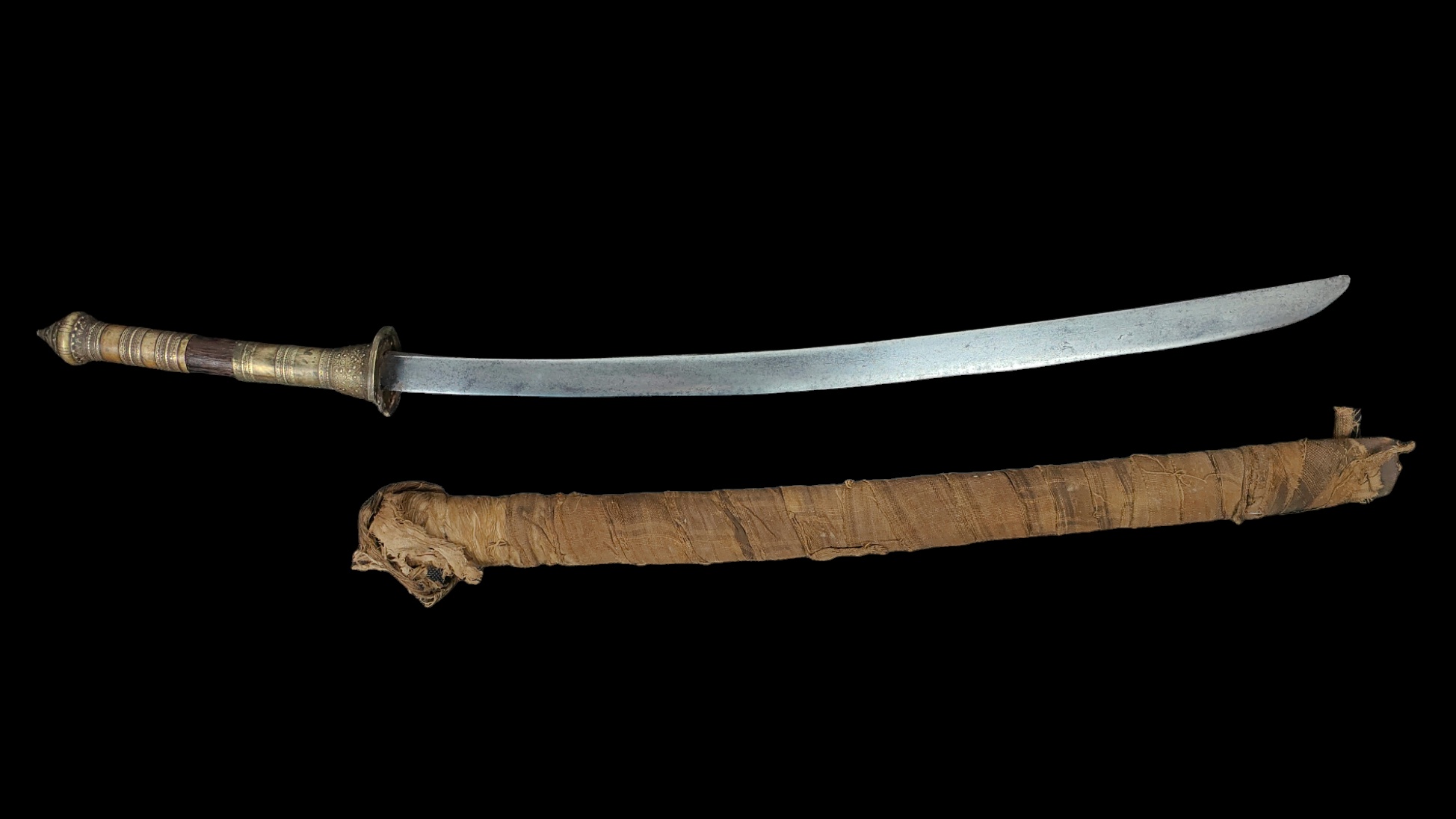
The Sword of the Elephant
November 14, 2023 Asian Arms
Laos is the smallest country in Southeast Asia by population and the most isolated, but it has always maintained an import role in the region's history. At times it was unified under a central kingdom known as Lan Xang, land of a million elephants, and in 1707 it splintered into regional kingdoms based around capitals such as Luang Prabang, Vientiane and later Champasak. These regions and kingdoms are various times fell into the sphere of influence of Ayutthaya/Siam, Burma and Vietnam, but have always played a role in the military strength and campaigns of each of these regional powers.
There is a particular form of sword common to Laotian troops most likely starting in the later part of the 17th or early 18th century that I would argue is semi-iconic with a distinct style. Often referred to as the Vientiane form by Thai collectors, it was in fact dispersed throughout a wider region than just that city. These swords are characterised by heavy, slashing oriented blades, hilts with cast bronze guards, ferrules and pommels, and organic grips. They are often made to a very similar pattern, pointing to a degree of mass production likely driven by the many military campaigns of the 18th century and early 19th century in the region.
In this sense they are similar to the highly sought after Ayutthaya patterns that were both widely produced but equally relied on conscription to power the military machine of the kingdom. This was a period of frequent conflict throughout Southeast Asia, including the disintegration of Lan Xang, the establishment of independent regional Lao kingdoms, the fall of the Toungoo dynasty in Burma and the ascendancy of the Konbuang dynasty. Ayutthaya was to fall in the mid 18th century, while Qing China would attempt multiple invasions of Burma. In short it was a period of upheaval and shifting power structures which saw Laotian soldiers engaged in wide ranging campaigns across the broader region based on the shifting allegiances of each Laotian kingdom and their own internal struggles against one another.

Lao smiths were highly valued by their Siamese and Burmese suzerains, with much of the skilled population moved to conquering cities, a common theme in Southeast Asian warfare where capturing populations was as valuable as territory. In the Lao context this was still occurring in the 18th century such as the mass movement of the population after the sack of Vientiane in 1779. This quality shows clearly in the blades of these swords which tend to follow a similar pattern with v-ridged spines but differences in length, curvature and exact proportions.
These swords tend to have somewhat shorter handles than many other dha/daab from Siam or Burma, with larger circular guards and very similar decorative motifs. The blades do differ as do the exact decorative motifs of the hilts, perhaps pointing to different production batches. Many of these pieces have damaged pommel or guard castings, while this could be attributed to battlefield damage, the regularity of these issues perhaps point to inherent issues with the production of these elements and an emphasis on speed of production over quality. It is perhaps a logical assumption that the mass production of hilt castings led to a degradation in quality.

The hilts, as with many Southeast Asian swords, follow a set of typical motifs, with the pommel reflecting a lotus bud, while the guards often have a semi-bulbous form with a wide lip that in some ways evokes an archaic tsuba.

This particular example is exceptional in that the grip retains all of the original material, comprising a wood core, covered with a woven wire mesh, filled with lacquer.

The position and composition of the grip are ideal for utilising the inherent cutting properties of the sword.
Some examples exhibit decorative engraving on the blades, while others are quite plain. Differences in the exact blade geometry and handle elements likely hint towards particular production centres and government contracts required to meet the needs of each regional centre and their ultimate quota of troops required to be outfitted and supplied to their suzerain. This likely also accounts for the quality of castings and fittings encountered on these pieces. Another prominent factor in the condition of 18th century war swords is the fact that most of these pieces saw substantial use, leading to a greater likelihood for extent examples to have some degree of damage.

This example has a lightly decorated blade with a very pronounced and wide tip and relatively narrow 'waist'. While others feature larger curvature with thinner spines and long blades.
.jpeg)
Short, heavy variants also exist, with this particular example featuring a very thick and substantial blade. Interestingly both of these two swords have damaged pommel castings. Meaning it was likely a common area for damage to occur.

The guard 'lip' is another area where damage seems to have been frequent as this next example shows.


The variety of these swords indicate that overall the basic design was dispersed across a wide area rather than purely focused on one metropolis and was probably in use for quite a long period of time. In Thailand they are dispersed across the Khorat plateau. Some have made a connection to this trend with the Lao rebellion of 1826-1828 and the campaigns of Anouvong of Vientiane's army, however Lao presence in the plateau has a long history since the 17th century and growing more common in the 18th century. This was also a logical route for armies traversing to Ayutthaya or in the case of the late 18th century campaigns involving Siam and Laos in the Tay Son conflict in modern day Vietnam. The kingdom of Vientiane extended to Roi Et (known as Sakhet Kakhon at the time) and controlled much of the northern part of the plateau. While the kingdom of Champasak controlled the center. Perhaps key to this period is understanding the messy dynastic politics and competition between Luang Prabang and Vientiane as well as the rebellion of Phra Ta and Phra Bo, two brothers who had supported king Ong Boun when he came to power in 1767. They did not receive the positions of power they had been promised and rebelled by setting up their own statelet at modern day Nong Bua Lamphu in the north of Isaan.
The triggered a chain of events with Vientiane attempting to crush the rebels, calling for aid from both the Siamese governor of Khorat and the Burmese. Eventually the two brothers were defeated in 1771 with one being killed and the other seeking refuge in nearby Champasak. Meanwhile Surinyavong II had taken the throne in Luang Prabang and in revenge for the support Vientiane had shown the Burmese which had led to an invasion of Luang Prabang in 1765, he in turned attacked Vientiane. Meanwhile the resurgent Siamese state under king Taksin was campaigning to regain control of Lanna and sever Burma's control of both Lanna and Lao. Vientiane was left trying to play both sides, with the Burmese holding members of Ong Boun's family hostage and Taksin's armies on their doorstep.
To cut a long story short, continuing tension between Champasak, Ong Boun and Phra Bo, which ended in Vientiane forces killing Phra Bo and finally ending that particular chapter of rebellion, Taksin invaded and destroyed Vientiane in 1779.
.png)
Southeast Asian polities circa 1750 (via Wikipedia)
While that is very much a simplification of the complex political and military situation of the time, it hopefully will illustrate to the reader that Vientiane was very much a key player in this period. On this basis these swords are indeed connected with Vientiane, but rather than a style specific to that city rather they are a form of sword that would have be found across central and southern Laos and the northern half of modern day Isaan.
These swords are not particularly common in Western auctions and are increasingly difficult to find in Thailand and Laos, although season collectors have indicated privately that they used to be more prevalent on the market. Despite the less than perfect condition of some of these examples I feel fortunately to own them as they are definitely swords made to be used, unlike some of the more highly decorated examples from the region that enjoy higher resale values. Sometimes finding pieces that give a truth insight into the past are worth more than perfection aesthetic condition and traditional ideas of collecting value.